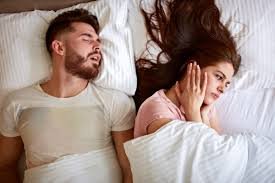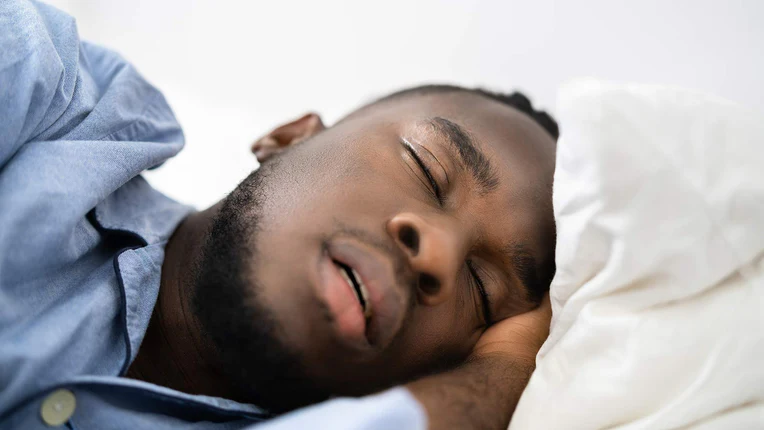Health Essentials
Not all snoring is created equal

Snoring is not only harmful to our physical health but it
affects all 6 pillars of wellness especially social wellness
When people are unable to differentiate between your snore and a locomotive engine or a trumpet that could break down walls, it may not just be a nuisance to your bed and housemates, but it may signal a serious medical condition.
Loud snoring may be a warning that you have Sleep Apnoea, a condition that opens doors to several serious life-threatening complications. Not every snoring is associated with sleep apnoea and also there may be sleep apnoea without snoring. Sleep medicine is no luxury, we need to do everything possible to get good quality sleep, especially when sleep is one of the greatest legal performance enhancing “drugs” known to man.

In sleep apnoea, breathing repeatedly stops and starts during sleep. It may be as often as 30 times in an hour. This shortchanges our brain of oxygen, and it is a potentially dangerous sleep disorder.
Types of Sleep Apnoea;
• Obstructive Sleep Apnoea (OSA)
o The commonest by far. Throat muscles relax and block flow of air
• Central Sleep Apnoea
o Brain does not send proper signals to muscles controlling breathing
• Complex Sleep Apnoea
What may signal Sleep Apnoea/ What to look out for
• Loud snoring.
• Episodes in which you stop breathing during sleep — which would be reported by another person.
• Gasping for air during sleep.
• Awakening with a dry mouth.
• Morning headache.
• Difficulty staying asleep, known as insomnia.
• Excessive daytime sleepiness, known as hypersomnia.
• Difficulty paying attention while awake.
• Irritability.
• You may just not be able to complete a movie.
• Involved in minor accidents at home, work or even on the road.
Get checked out. Even children may suffer from sleep apnoea.
What increases our chance of developing Sleep Apnoea?
• Excess weight or fat.
• Neck circumference. People with thicker necks might have narrower airways.
• A narrowed airway. Tonsils or adenoids also can enlarge and block the airway, particularly in children.
• Being male. Men are 2 to 3 times more likely to have sleep apnoea than women. However, women increase their risk if they’re overweight or if they’ve gone through menopause.
• Being older. Sleep apnea occurs significantly more often in older adults.
• Family history. Having family members with sleep apnoea might increase your risk.
• Use of alcohol, sedatives or tranquilisers.
• Smoking. Smokers are three times more likely to have obstructive sleep apnoea
• Nasal congestion. If you have trouble breathing through your nose — whether from an anatomical problem or allergies — you’re more likely to develop obstructive sleep apnoea.
• Medical conditions. Congestive heart failure, high blood pressure and type 2 diabetes are some of the conditions that may increase the risk of obstructive sleep apnoea. Polycystic ovary syndrome, hormonal disorders, prior stroke and chronic lung diseases such as asthma also can increase risk.
What complications may occur from untreated Sleep Apnoea
Sleep apnoea is a serious medical condition. Complications of OSA can include:
• Daytime fatigue. The repeated awakenings associated with sleep apnoea make typical, restorative sleep impossible, in turn making severe daytime drowsiness, fatigue and irritability likely.
You might have trouble concentrating and find yourself falling asleep at work, while watching TV or even when driving. People with sleep apnea have an increased risk of motor vehicle and workplace accidents.
You might also feel quick-tempered, moody or depressed. Children and adolescents with sleep apnea might perform poorly in school or have behavior problems.
• High blood pressure or heart problems. Sudden drops in blood oxygen levels that occur during OSA increase blood pressure and strain the cardiovascular system. Having OSA increases your risk of high blood pressure.
OSA might also increase your risk of recurrent heart attack, stroke and irregular heartbeats, such as atrial fibrillation. If you have heart disease, multiple episodes of low blood oxygen (hypoxia or hypoxemia) can lead to sudden death from an irregular heartbeat.
• Type 2 diabetes. Having sleep apnoea increases your risk of developing insulin resistance and type 2 diabetes.
• Metabolic syndrome. This disorder, which includes high blood pressure, abnormal cholesterol levels, high blood sugar and an increased waist circumference, is linked to a higher risk of heart disease
• Liver & kidney problems
• Sleep-deprived room or house mates
• Complications during surgery and also with some medication
Lifestyle Modifications that may help
• Lose excess fat. Even a slight weight loss might help relieve constriction of your throat. In some cases, sleep apnea can resolve if you return to a healthy weight, but it can recur if you regain weight.
• Exercise. Regular exercise can help ease the symptoms of obstructive sleep apnea even without weight loss.
• Avoid alcohol and certain medicines such as tranquilisers and sleeping pills. These relax the muscles in the back of your throat, interfering with breathing.
• Sleep on your side or abdomen rather than on your back. Sleeping on your belly has many posture related challenges but we may adopt that briefly as we work on definitive treatment.
• Don’t smoke.
Diagnosis and Treatment
There is help so if you think you may have sleep apnoea do not hesitate to speak to your doctor.
A few questions, examination and Sleep Studies and a diagnoses may be reached and the appropriate treatment, advice or support systems put in place.
Yes, the options vary from just lifestyle modifications to the famous CPAP, implants and even surgery BUT do seek help, not only will you feel brand-new when the condition is resolved, you may be saving relationships.
……definitely not all snoring is created equal. Find out about yours.
AS ALWAYS LAUGH OFTEN, ENSURE HYGIENE, WALK AND PRAY EVERYDAY AND REMEMBER IT’S A PRICELESS GIFT TO KNOW YOUR NUMBERS (blood sugar, blood pressure, blood cholesterol, BMI)
Dr. Kojo Cobba Essel
Health Essentials Ltd (HE&W Group)
(dressel@healthessentialsgh. com)
*Dr. Essel is a Medical Doctor with a keen interest in Lifestyle Medicine, He holds an MBA and is an ISSA Specialist in Exercise Therapy, Fitness Nutrition and Corrective Exercise. He is the author of the award-winning book, ‘Unravelling The Essentials of Health & Wealth.’
Thought for the week (1) – “I am hard pressed to choose the greatest legal performance enhancing drug. Is it good quality Sleep or Exercise?”
References:
1. www.mayoclinic.org
2. Team at Penn State Health Holy Spirit Sleep Center
- Snoring is not only harmful to our physical health but it affects all 6 pillars of wellness especially social wellness.
By Dr. Kojo Cobba Essel
Health Essentials
At Easter should Spiritual Wellness be the only form of Wellness?

Many of us have already packed our Easter season with so much work and back-to-back programmes we hardly have time to breathe.
The little time we can squeeze out is used to stuff ourselves with food and drinks, but for this season and beyond we may be able to spend five minutes even on extremely busy days to make a difference in our lives so that we can have time to sing, dance and worship God as we remember his unparalleled sacrifice to us.
My-in-laws who reside on the mountain are busy trekking up and dragging their friends and colleagues with them. Any idea why the Kwahus revel in Easter? Has it always been that way or is it a conscious effort to show Ghana and the world what they have?
We all wish our favourite exercises will give us the same benefits as all other exercises but the truth is that some exercises are “more equal than others” just as happens in every aspect of life.
This does not mean if you are unable to perform the most effective exercises, you should exert yourself and cause injury to your body. Remember, Cobba’s First Law of Exercising is “DO NO HARM”.
These exercises may just help you stay afloat this Easter:
• Squats
• Plank
• Push-Ups
• Walking & Dancing
Squats
Every single rep (repetition) in this exercise is worth the effort.
Squats target the quadriceps, hamstrings and gluteals, which in simple language refers to the thigh muscles and buttocks.
It is important to learn the right technique and since it exercises large muscle groups, you are able to burn a lot of calories with squats.
In every exercise session, it is important to work large muscles before the smaller ones.
Steps
1. Keep feet shoulder width apart
2. Back should be straight (standing posture)
3. Bend knees and lower your rear till your thighs are horizontal.
4. Return to the standing position
5. Repeat steps 1-4
6. Remember to stretch the muscles used after the exercise.
If you have difficulty following the steps above, place a chair behind you and with your back straight try to sit on it. Do not let your buttocks touch the seat, then return to the standing position and repeat. As your technique improves, you may remove the chair.
As one gets stronger you may even carry some weights while doing squats but as always start with caution. You may do only 3 reps at a time (properly). Gradually, add some more.
When to avoid squats
• Severe knee pain irrespective of cause
• Knee injury even if no longer painful (you will need professional supervision)
• Acute back pain (you will later do back slides which is similar to squats and helps strengthen back muscles)
This exercise benefits almost everyone with a lifestyle disease. Hypertensives (those with high blood pressure) even get a bonus since it causes peripheral pooling of blood and helps to lower the blood pressure over time.
Plank

Arguably, the safest exercise for strengthening abdominal muscles and also has the added benefit of strengthening lower back muscles. Especially for people who sit for long hours (you shouldn’t anyway) this is great news for helping your back.
1. Start by getting into a push-up position
2. Bend your elbows and rest your weight on your forearms and not on your hands
3. Support your lower body on your toes
4. Your body should form a straight line from shoulders to ankles just like a plank of wood
5. Engage your core (midsection) by sucking your belly button into your spine
6. Hold this position for the prescribed time. This may vary from 5 seconds to 1 minute. Repeat.
Push-ups (press-ups)
This is probably the first exercise most people try out; well apart from laughter and walking I presume, and everyone is familiar with it.
Go ahead and squeeze a minute a day in there.
Walking & dancing
Before you set out to exercise your muscles remember to walk at least a minute before you start and a minute after you are done.
You may even walk while in one place, what matters is moving your legs and arms and getting your heart to pump.
Use every opportunity during the day to:
• use the stairs instead of the elevator
• walk while you talk on your cell phone
• Walk to a colleague’s desk at the office instead of using the phone or sending someone else.
• Pick your own stuff for cooking instead of sitting and getting people to assist with even the trivial errands
• Dance with your heart whenever you have a chance; during your Christmas programmes, while watching TV and even while you take a shower.
A minute each for Squats, Planks and Push-ups and two minutes of walking every morning, afternoon or evening may just be enough to get you through the season and certainly it will not tamper much with your tight holiday schedule. Do not forget to smile often, breathe deeply to relax, enjoy some sunshine, pray, praise and worship God and you will be on the right path especially if you keep an eye on your finances and learn to unplug several hours each day.
In my opinion, every aspect of Wellness is important at all times and we should try to keep a balance. Neglecting all other aspects (Physical, Social, Mental, Digital, Financial & Spiritual) and focusing only on Spiritual Wellness will mean we will not be able to perform at our very best and certainly our Maker needs the best version of us.
AS ALWAYS LAUGH OFTEN, ENSURE HYGIENE, WALK AND PRAY EVERYDAY AND REMEMBER IT’S A PRICELESS GIFT TO KNOW YOUR NUMBERS (blood sugar, blood pressure, blood cholesterol, BMI)
Dr Kojo Cobba Essel
Health Essentials Ltd/ Medics Clinic
(dressel@healthessentialsgh. com)
*Dr Essel is a Medical Doctor with a keen interest in Lifestyle Medicine, He holds an MBA and is an ISSA Specialist in Exercise Therapy, Fitness Nutrition and Corrective Exercise. He is the author of the award-winning book, ‘Unravelling The Essentials of Health & Wealth.’
Thought for the week – “For heart health you need to relax and have fun as well; schedule time for leisure, sing praises to God, laugh often, learn to breathe deeply and maybe get a pet.”
References:
• The Gym Bible
• www.webmd.com
• 30dayfitnesschallenges.com
By Dr Kojo Cobba Essel
Health Essentials
Hijab (Islamic Veil) as an Act of Worship
Alhamdulillah (all praise is due to Allah), the Creator of the heavens and the earth, the One who guides us to the straight path.
We bear witness that there is no deity worthy of worship except Allah alone, and we testify that Muhammad (peace and blessings be upon him) is His servant and Messenger.
May Allah’s peace and blessings be upon him, his family, and all who follow him in righteousness until the Last Day.
Introduction
Dear respected brothers and sisters in Islam, today’s khutbah addresses an essential act of worship that embodies submission, modesty, and obedience to Allah: the “Hijab”.
While the Hijab is an explicit command from Allah, it is also a human right protected under local and international laws.
It is imperative that Muslim women are allowed to observe Hijab freely, especially in public institutions such as universities, banks, ministries, public health institutions, and government agencies.
Definition and Meaning of Hijab
In Islam, Hijab refers to modesty in appearance and behaviour. For women, this includes covering the body, except for the face and hands, in non-revealing clothing (not skin-tight), while for men, it includes covering from the navel to the knees and dressing modestly.
The Hijab extends to lowering the gaze, avoiding indecent speech, and conducting oneself with dignity.
Allah commands:
“And tell the believing women to lower their gaze and guard their private parts and not to display their adornment except that which [ordinarily] appears thereof and to wrap [a portion of] their headcovers over their chests.”
(Quran 24:31).
Essence of Hijab as an Act of Worship and Modesty
The Hijab is an act of worship rooted in obedience to Allah. It is not a cultural practice but a divine command. Allah says:
“O Prophet, tell your wives and your daughters and the women of the believers to bring down over themselves [part] of their outer garments. That is more suitable that they will be known and not be abused. And ever is Allah Forgiving and Merciful.”
(Quran 33:59).
The Hijab is a reflection of one’s faith, modesty, and inner character. It shields the individual from immorality and contributes to the moral fabric of society.
Lowering the Garments and the Gaze
The Hijab also encompasses lowering the gaze and maintaining purity in interactions between genders. Allah says:
“Tell the believing men to lower their gaze and guard their private parts. That is purer for them. Indeed, Allah is Acquainted with what they do.” (Quran 24:30).
By lowering the gaze, both men and women protect themselves from sin and maintain mutual respect.
Social Menace and Immoralities Due to Lack of Hijab
The absence of Hijab in society has led to numerous social issues, including:
Zina (Adultery and Fornication): Unrestricted interactions and immodesty increase the likelihood of adultery and fornication, which Allah explicitly prohibits:
“And do not approach unlawful sexual intercourse. Indeed, it is ever an immorality and is evil as a way.”
(Quran 17:32).
Exploitation and Objectification:
When modesty is neglected, individuals, especially women, are objectified and exploited, resulting in an increase in harassment and sexual abuse, a phenomenon that has plagued many organissations such as Universities, Banks and other public institutions. The introduction of Sexual Harassment Policies with its attendant harsh punishments has done very little in resolving this menace.
By Imam Alhaji Saeed Abdulai







